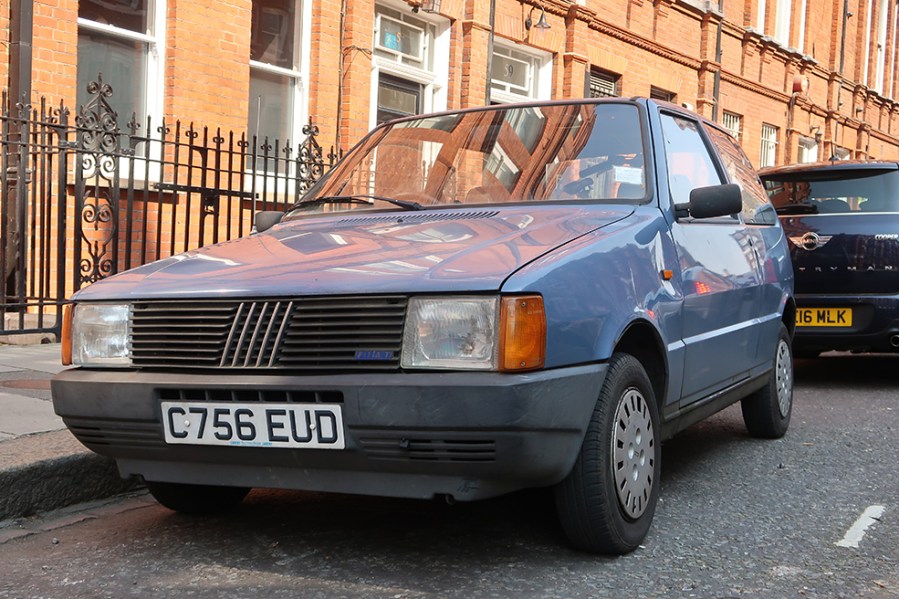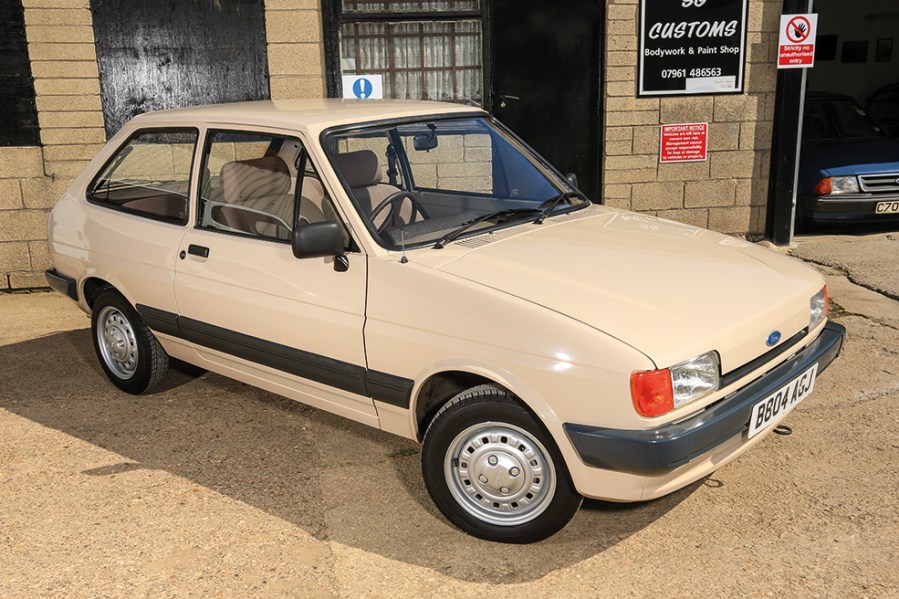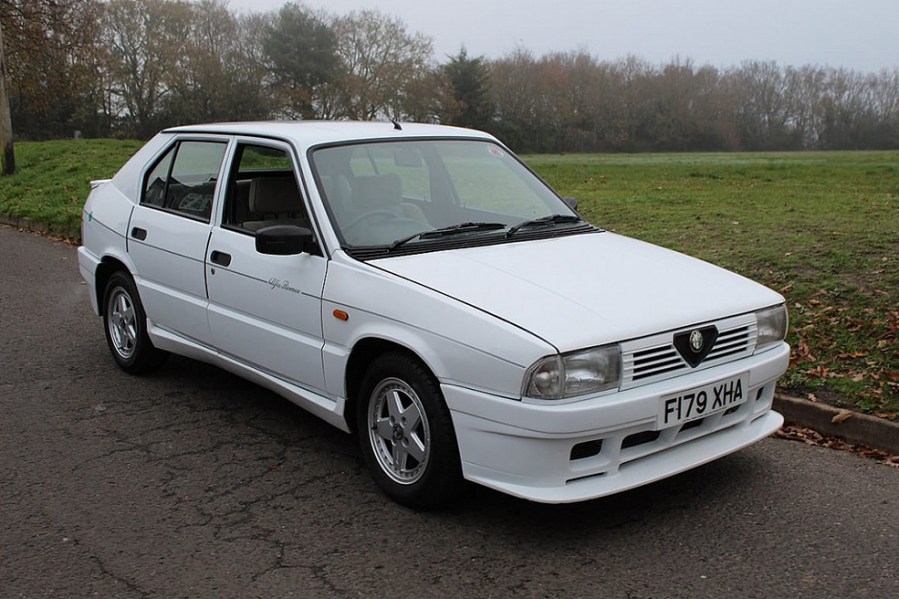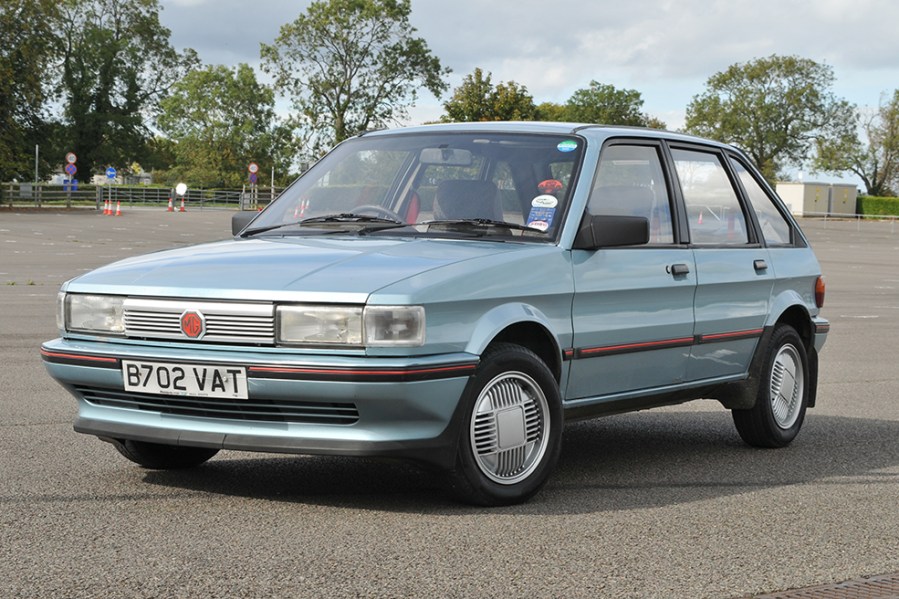Four decades ago a raft of new model launches introduced many cars we now hold dear. We pay homage to the best classic cars of 1983
Words: Simon Jackson
Austin/MG Maestro
The genesis of the 1983 Maestro can be traced back to the middle of the 1970s. Created as a replacement for the ageing Allegro, Marina and Maxi, it was developed along conventional paths in the vein of the Volkswagen Golf and forthcoming Ford Escort Mk3 – so no Hydragas suspension here. Following a somewhat drawn-out development programme, it was March 1983 before the Maestro was officially launched.
Engine options first consisted of the entry-level 1.3 or 1.6-litre units, with trim levels ranging through L, HLE, Vanden Plas and the sporty, range-topping MG Maestro. While the A-Plus 1275cc engine offered acceptable levels of performance and was noted for its efficiency, the larger 1.6-litre R-Series was a development of the E-Series and nothing more than a stopgap, as it was always set to be replaced in the Maestro by the revised S-Series at the launch of the Montego in 1984.
Road testers in period largely praised the ride and handling of the Maestro, but in the face of stiff competition from the likes of Ford, VW, Vauxhall, and the popular French marques of the time, it was all acceptable rather than revolutionary and astounding.
That said, the Maestro did break new ground in a couple of ways. Body-coloured bumpers and a bonded laminated windscreen might have been unusual at the time, but more interesting was the adoption of the infamous talking dash in the MG and Vanden Plas models (and optional on the 1.6HLS). It provided an LED display of the car’s vital and spoke a total of 32 words, and though it was largely an unashamed marketing gimmick, it was a fun one at that.
In summer 1984 the MG Maestro adopted a twin-carb version of the Montego’s aforementioned 1.6-litre engine, but this would be quickly replaced by the 2-litre fuel injected O-Series unit. The bigger engine really made the Maestro a hot-hatch contender, and the heat was turned up even further when the Turbo was launched in 1988.
In 1987, the Austin badges were discontinued, but the Maestro soldiered on, despite the range being pruned in later years. BMW top dog, Bernd Pischetsrieder, was reportedly surprised to find the Maestro still in production in 1994 when he took over control of the brand. Even that wasn’t the end though, with cars built in Bulgaria from CKD kits reimported to the UK as sold as late as 2001, and the tooling used in China for several years thereafter.

Fiat Uno
The replacement for the Fiat 127 arrived in 1983, designed by none other than Giorgetto Giugiaro of Italdesign. Reflecting the period, the Uno’s dimensions and boxy look differed quite radically from its forebear. While it retained a similar supermini concept, it was both more practical and efficient, its styling characterised by a squared-off, Kamm tail, rump that would become somewhat ingrained in Fiat’s design language for a time.
Two body styles, three and five-door, were available when the Uno launched in the UK in the summer of 1983. Engine choice was initially carried over from the 127, ranging from the base 903cc offering, to 1.1 and 1.3-litre petrol motors. Model badging reflected the horsepower output of the engine – starting at ’45’ and ultimately rising to ’75’. Worthy of mention too, are the models equipped with the Selecta CVT gearbox – a clever automatic available from 1988.
Beating the Peugeot 205 to the European Car of the Year crown for 1984, the Uno enjoyed a positive reception and, in 1985, its mechanicals were updated. In came the 1.0-litre Fully Integrated Robotised Engine (FIRE) engine, which was lighter, more powerful and more economical than the old entry-level unit it replaced. That same year saw the birth of an icon. The Uno Turbo i.e was available in three-door guise only, utilising a 104bhp turbocharged version of the 1.3-litre 128-series engine, mated to a five-speed gearbox. First coming in 1299cc capacity, it was later uprated with to 1301cc to circumnavigate Italian motorway rules. The Turbo looked the part thanks to its bodywork additions, lowered suspension, 13-inch alloy wheels and sports seats.
A facelift of 1989 gifted the whole Uno range a refreshed look, with a revised engine line-up including a Tipo-based 1.4-litre engine – normally aspirated and turbo. The extra capacity would see the second-generation Uno Turbo become even more popular among young drivers.
By 1992 even the smaller 1.0 and 1.1-litre engines employed fuel injection, bringing them more up to date, but in 1995 Uno production in Italy ended. That said, the Uno continued to be produced in Poland, and later Brazil where it was built until as recently as 2014.
Around 300,000 examples were sold in this country between 1983 and 1995, with the first-generation version being one of the UK’s most popular imported cars.
Peugeot 205
One of the most influential small cars of the 1980s, arguably of all time, the Peugeot 205 was designed to take on the likes of the Renault 5 and Ford Fiesta. Plugging the gap between 104 and 305, the roots of the 205 – designated internally as ‘Project M24’ – can be traced all the way back to 1977. With the union between Citroënmand Peugeot of 1974 still shaping what became PSA, the 205’s development would prove crucial for a firm in need of a cash cow. Famously, Peugeot rejected a Pininfarina design in favour of Gerard Welter’s clean lines.
In January 1983, the wraps came off the range of hatchbacks. Prices in the UK started at £3895 for the entry-level model, with petrol models available in GL, GR and GT guises, and the GLD and GRD diesels powered by the XUD motor pinched from the Citroën BX. The 205 narrowly lost the European Car of the Year award for 1984 to Fiat’s Uno, but ironically has had a far more lasting legacy than its Italian rival.
Such was the reception to the 205’s overall package and looks that it was barely changed during a successful 15-year production run. Mild revisions took place in 1988 with a tweaked dashboard and new TU engines, and in late 1990 the more obvious changes occurred with updated exterior lighting and engine revisions designed to combat the pollution limits of 1992. The dTurbo model of 1991 was well received and arguably ahead of its time, instantly identifiable via its raised bonnet.
However, the 205 is probably best remembered in GTI guise. The 104bhp 1.6-litre GTI arrived in 1984, whipping rivals like the Fiat Uno Turbo, Golf GTI and Renault 5 GT Turbo into shape. Power rose to 115bhp for 1987, partly overshadowed by the arrival of the 126bhp 1.9-litre GTI that same year, though which is the better car remains a divisive topic. In short, the 205 GTI became – and still remains for many road testers – the benchmark for how a hot hatch should drive.
Of course, there was also the CTI convertible, the Rallye and fearsome T16 Group B car to add to the 205 legend. The 205 went off sale in UK in 1996, but its star still burns brightly. British firm Tolman Engineering is rebuilding GTIs as upgraded restomods, while Peugeot’s own heritage department is now restoring cars in France, too.

Land Rover One Ten
A milestone moment in Land Rover history, the coil-sprung One Ten was introduced in 1983 – the name referring to its wheelbase in inches. Replacing the Series III that came before it, the Land Rover we now know as the Defender wasn’t wildly different from the vehicle it replaced, at least not to look at.
The biggest changes to the One Ten, and Ninety which arrived one year later, were mechanical; the suspension, permanent four-wheel-drive and a two-speed gearbox with lockable differential being the salient points. Initially powered by a 2286cc diesel engine, this was soon replaced by a 2495cc unit. The Ninety was launched with four-cylinder engines, while in 1985 a V8 was made available. That same year saw the 2286cc petrol superseded by a 2495cc motor, and in 1986 a new 85bhp 2495cc turbo-diesel was launched. When the Defender arrived in 1990, the Ninety and One Ten range were renamed as Defender 90, 110 and 130.
The One Ten marked an interesting turning point for Land Rover in 1983, over and above the transition from leaf to coil springs. The British brand began painting its mainstay as a private recreational vehicle, rather than purely a commercial, utility vehicle. An improved all-round ability certainly contributed to the model’s success.
Vauxhall Nova
Launched in mainland Europe in 1982, it was 1983 before the Nova – known as the Corsa A overseas, made it to UK shores. Part of the seven-month delay could be attributed to a British union dispute, fuelled by anger over the Nova being built abroad and not at Luton or Ellesmere Port, while further complications over import duties didn’t help either.
Development for the Opel Kadett and Vauxhall Chevette replacement was conducted by Opel in Germany, with the car manufactured at the General Motors plant in Spain. On the outside, the work of Stuttgart university and Pininfarina certainly paid off via the Nova’s low drag coefficient, as well as those memorable box arches on the three-door hatch. Underneath, MacPherson struts at the front and a torsion beam rear axle were very much fit for purpose if not groundbreaking, and it was a similar story for the engines, with 1.0, 1.2 and 1.3-litre engines, the latter powering the sporty SR model, which was superseded by the 1.4-litre SRi in 1988. The 500-off Sport homologation special would also be produced in 1985.
The Frankfurt Motor Show in 1987 saw the launch of the 1.6-litre GSi, badged as a GTE initially in the UK. Breathed on by Opel tuning specialist, Irmscher, the performance variant boasted around 100bhp.
A massive sales phenomenon, the British market lapped up the Nova in every guise; whether three or five-door hatches, two and four-door door saloons or even a van variant. At the height of its popularly in 1989 it was Britain’s seventh best-selling car – Vauxhall shifted more than 70,000.
A facelift arrived in 1990 with mildly revised styling up front alongside a refreshed interior. In the spring of 1992, the last car would leave the Zaragoza plant – 1993 being the final year of this much-loved model, which by then looked somewhat dated.
In the years that followed, the Nova spent many of them in the doldrums and had a poor reputation for being badly modified and driven by boy racers. However, good examples are now highly prized, especially the sporting models.
Ford Orion
Following in the tyre tracks of a new wave of Ford models, including the Escort Mk3 and Sierra hatchbacks, the Orion arrived in 1983 to fill the void for a four-door family saloon left by the demise of the Cortina during the previous year. It took its styling cues from the Escort, but the three-box saloon was characterised by its long flat boot and plusher spec.
Initially available in GL and Ghia trim with 1.3 and 1.6-litre CVH engines, in 1984 an entry-level L model arrived alongside the option of a 1.6 diesel power plant.
A facelift arrived in 1986, coinciding with that of the Escort. This saw the Orion range expanded with the addition of further entry-level models, plus a new 1.4-litre lean-burn petrol engine. Later models would include the leather-clad 1600E, reviving a model designation used on the Mk2 Cortina in the 1960s.
The Orion sold well in the UK and was consistently in the top 10 best-selling cars in the country between 1984 and 1990, but in the face of ever stronger competition, it was replaced by the third incarnation in 1990. Again, this shared much with its Escort relation of the era, yet it did not sell as well. In 1993 the Orion name was no more, with the saloon models now badged as Escorts before being discontinued in 1998.

Ford Fiesta Mk2
By the time production of the Mk1 ceased in 1983, the Fiesta had dropped to fifth in the UK sales chart, so to keep things fresh in light of competition from the Metro, Ford came out fighting with the Mk2 Fiesta. The basic underpinnings and bodyshell were largely the same as the previous car, but its rough edges were smoothed off in more ways than one, feeling more refined to drive as well as ushering in softer front-end styling and a revised tailgate.
Along with re-jigging the chassis rails and making a few other structural changes, the rounded bonnet and wings allowed enough space to squeeze in the 1297cc CVH engine from the Escort with its five-speed gearbox. The smaller OHV engines remained in lightly tweaked form, and for the first time there was a 1.6-litre diesel that’s now exceptionally rare.
Initially buyers could choose from the Popular, Popular Plus, L and Ghia, with the sporty XR2 quickly added in 1984 with a 12bhp power improvement on its predecessor. Rather than the old Crossflow, the XR2 was fitted with the same 1596cc CVH engine as fitted to the Mk3 Escort XR3.
Further changes included the 1.3 motor being superseded by a 1.4-litre lean burn unit, which was also fitted to the 1.4 S model launched in 1986, designed to appeal to those looking for a sporty option without the XR2 price tag. Ford’s continuously variable transaxle transmission (CTX) was also offered on 1.1-litre cars from 1987.
With a large array of models and special editions, the Mk2 proved popular right up until it made way for the Mk3 in 1989. Its best year was 1987, with over 150,000 sold. Thanks to a strong following, good spares availability and that desirable Blue Oval on the bonnet, the Mk2 is well on its way to being seeded in the classic car world. Act quickly if you want one.

Alfa Romeo 33
The successor to the Alfasud, known internally as the ‘Type 905’, arrived in 1983 as a five-door hatchback with much to live up to. Early examples of the 33 suffered with build quality issues which didn’t exactly help enamour it to the press or public, however it boasted several innovations over the car it replaced – including a dashboard binnacle that moved with the adjustment of the steering wheel. Adding to the charms of the 33 were its unique, boxy-style, decent handling and sonorous boxer-engines.
Two models were made available at first, powered by 1.3 and 1.5-litre units carried over from the ‘Sud, Alfa soon added an estate version. Interestingly, in 1.5 4×4 guise, the 33 estate’s all-paw system could be switched by the driver at any speed, changing it from front to four-wheel drive.
In 1987 came a mild facelift, with it a 116bhp 1.7-litre Boxer motor, the UK market got 1.5 and 1.7 Green Cloverleaf hatchback and 1.7 Sportwagon estate models. The following year Alfa made its final round of mild updates before the major facelift of 1990, with an extensive redesign giving rise to the second series cars built until 1995, when the 33 was replaced by the 145 and 146.
Nowadays, the 33 is rare in the UK, with only a handful of cars usually available on the market. Go shopping in Continental Europe, however, and you’ll find a surprising amount of survivors.






